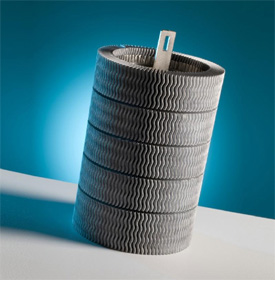Jul 25 2010
On July 24, 2008, a hydrogen plant in Europe - the first to use a metal foil catalyst substrate in place of ceramic pellets - achieved expected performance at startup with minimal correction; reactions were observed to operate at exact equilibrium. The novel catalyst - the Stackable Structural Reactor (SSR®) from Catacel Corporation - has, as of today, achieved 17,500 hours problem-free operation; performance remains indistinguishable from new.

The SSR® is made from a special grade of high temperature steel alloy foil coated with a reforming catalyst. It was designed by Catacel to resolve the deficiencies of traditional catalyst-impregnated ceramic media; namely inefficient heat transfer and degradation of performance due to "crushing to powder" after repeated startup/shutdown cycles.
The 250-m3/hr European hydrogen plant was built to supply a Borcelik steel facility with hydrogen gas for annealer and coating line operations. Upon startup, furnace temperatures registered lower than a comparable older plant operating at the Borcelik location with conventional ceramic media. Performance was again evaluated in April 2009. No discernable change from initial performance was observed. At this time, the old plant was restarted to perform a similar evaluation; furnace temperatures and fuel consumption rates were observed to be considerably higher than the new plant.
While principally anecdotal with respect to confidentiality constructs, the results of the Borcelik installation suggest Catacel's SSR® as a practical alternative to ceramic catalyst media and to lower-cost hydrogen production via:
- Improved heat transfer equating to lower furnace temperatures equating to less fuel consumption;
- Durable metal foil design with greater catalytic surface area equating to longer life and lesser degradation of catalytic activity during its useful life;
- In retrofit plants, improved heat transfer equating to greater throughput yield from existing equipment equating to avoidance of additional capital investment;
- In new plants, improved heat transfer and longer life equating to fewer and/or shorter reformer tubes equating to reduced construction cost.
Furthermore, tests conducted in collaboration with the NASA Glenn Research Center (Cleveland, Ohio) have demonstrated 30% heat transfer improvement over ceramic media.